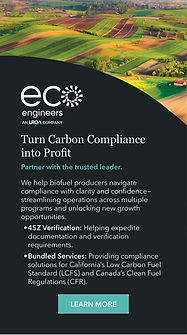Missouri’s Claim to FAME
- Ron Kotrba

- Jun 11, 2023
- 7 min read

The American industry of fatty acid methyl esters (FAME), better known today as “biodiesel,” owes its storied existence to forward-thinking Missouri soybean farmer-leaders.
Had Kenlon Johannes never had his “feathers ruffled” by a research paper more than 30 years ago, the biodiesel industry of today may have never materialized. So claims Alan Weber, an agricultural economist and M4 Consulting Inc. co-founder and partner, who jokes that the former Missouri Soybeans executive director reading a research paper about developing canola biodiesel was all it took to start “this whole thing.”
What Johannes started, of course, was the U.S. biodiesel industry. It provided soybean farmers with a high-volume, value-added use for the mounting stocks of soybean oil accumulating across Missouri and the broader Midwest in the late 1980s and early 1990s. Voluminous oil surpluses were a drag on the whole soybean market, depressing farmgate prices. Food uses for soybean oil—mayonnaise, salad dressing, deep-frying oil and the like—only consumed so much. Something had to be done. And Missouri Soybeans, with Johannes’ leadership, did it.
The use of vegetable-oil fuel in compression-ignition engines goes all the way back to the late 1800s and Rudolf Diesel himself. However, the U.S. crude-oil boom in the early 20th century led to cheap and abundant distillates, sidelining the development of vegetable oil for fuel.
Not until the energy crisis of the 1970s would curiosity in fuel alternatives be reinvigorated in America and abroad. Thanks to Martin Mittelbach at the University of Graz in Austria, who thought the molecules of vegetable oils were too bulky, esterified rapeseed and, later, used fryer oils, were showing much promise as a better pathway to new diesel-fuel alternatives. In the U.S., researchers including Chuck Peterson at the University of Idaho and Carroll Goering at the University of Illinois also began to better understand how vegetable oils could be used as fuels.
The central problem with vegetable oil was that it gummed up engines after prolonged use. Transesterification with alcohol and a catalyst produced fatty acid methyl esters (FAME) or fatty acid ethyl esters (FAEE). This eliminated the problem of gunked-up engines while providing lubricity, an attribute that would greatly benefit the movement in years to come.
Research persisted throughout the 1980s. In 1991, when Johannes heard about this new canola-based “biodiesel fuel,” he had a vision of what could be possible for his constituents and their soybeans: soy diesel. With a $22,000 investment, Missouri Soybeans funded a research project by Leon Schumacher at the University of Missouri. The researcher would test and demonstrate this new esterified soybean oil as a diesel-fuel replacement in a new Dodge pickup. Although Goering in Illinois had been testing esterified soybean oil, the fuel hadn’t been tested in real-world conditions.
Next, Johannes approached serial entrepreneur Bill Ayres, who had been tinkering with biodiesel in Kansas City, and his longtime friend and partner Doug Pickering to see if they’d be interested in making fuel for the project. Ayres ultimately agreed, and the seeds of an American biodiesel industry took root in a trash-can reactor, sump pump and cone-bottom drums.
An Organized Effort
In 1992, with funding from members of Qualified State Soybean Boards, Missouri Soybeans formed the National Soy Fuels Advisory Committee to further investigate what was needed to get a U.S. soy-diesel industry off the ground. Information Resources Inc. was contracted to provide a plan to develop markets and the technical proof, specifications and education needed to build an industry. An important takeaway from this report was that a trade association must be formed to establish the soy-diesel sector in America.

In less than a year, the National Soy Fuels Advisory Committee was disbanded to form the National SoyDiesel Development Board. The NSDB was organized with more than a half-dozen states as charter members, each contributing $10,000. Johannes stepped down from Missouri Soybeans to chart the course for the new association, which was tasked with creating a new fuel industry, markets, technical specifications, policy support, and all the testing and demonstrations to buttress these developments.
The new NSDB, which formed in late 1992, didn’t spread its wings and fly the nest, though. Rather, it occupied office space in the basement of Missouri Soybeans and was co-located with its “parent” organization for many years in Jefferson City. Johannes continued to secure funding, a major portion of which came from the United Soybean Board.
Early-Producer Nexus
Interest in soy diesel was growing at a fast clip. Ayres and Pickering secured demonstrations with the St. Louis Lambert International Airport, cooperatives, city bus fleets, boaters and even the Sunrider expedition that circumnavigated the globe. Ayres and his company, Interchem, had plans to build a production facility in Kansas City. Scaled at 2.1 million gallons per year, it would have been the nation’s first dedicated soy-diesel plant. However, when Ayres learned a nearby Proctor & Gamble plant was already making methyl esters, plans for the new facility were scrapped. P&G began providing FAME for testing and the growing list of demonstrations.
It was around this time that a great nexus took place as those who would become major players in biodiesel would connect. Gary Haer—who would later become a superstar with Renewable Energy Group (REG), renowned for door-to-door sales of 5-gallon pails of biodiesel—was hired by Interchem. John Campbell of Ag Processing (AGP), who greatly influenced biodiesel policy, attended Ayres’ plant kick-off ceremony for the facility that never came to be. Interchem and what became Midwest Bio-Fuels eventually struck deals with both AGP and West Central Cooperative, the roots of REG, to build what are considered the first dedicated U.S. soy-diesel plants in Iowa.
Another important person in the biodiesel community also intersected with Ayres and Interchem early on: Missourian Steve Howell. Working for Stratco at the time, Howell became immersed in biodiesel. He shared ideas, engineering plans and a FAME pilot plant with Interchem and Ayres. Eventually, Howell and Weber formed MARC-IV (now M4), which stands for “market analysis, research and consulting.” Howell worked to secure a fuel specification, a yearslong battle that eventually culminated in ASTM D6751 in the early 2000s.
Ayres also did business in the mid- to late 1990s with Gene Gebolys, founder of World Energy, which, years later, became one of the largest pureplay biobased diesel producers in North America. Gebolys, who many considered tenacious and relentless, was a young up-and-comer in the biodiesel world. He respected what soybean farmers brought to the biodiesel table. According to Ayres, he was selling Gebolys biodiesel and fronted the young go-getter volumes when he was struggling.
The pieces of the puzzle of what would become a uniquely American biodiesel industry were being put into place.
A Feedstock-Neutral Board
In 1994, just two years after its formation, the NSDB made the difficult decision to change its name to the National Biodiesel Board. It did not come without a fight or the possibility of major backlash from soybean farmers, some of whom were skeptical about becoming a feedstock-neutral organization. Those who approved the move realized that if biodiesel took off, they would need everyone and every feedstock onboard to provide the membership funding, political influence, marketing and, of course, the raw materials to see it through.

Johannes eventually stepped down from NBB leadership. Jeff Horvath led the organization for a few years until another Missourian, Joe Jobe, NBB’s chief financial officer, took the helm and guided the organization for 15 years.
It was about this time that the all-important health-effects testing was underway, a necessary step toward biodiesel becoming a legitimate fuel in the U.S. per EPA requirements. After rigorous testing and millions of dollars, biodiesel obtained its legitimacy. Biodiesel producers could either go through the time and expense of doing the same, or join NBB and be given access to the data. This began a period of expansive growth for the Missouri-born national trade association and the industry it represented.
Enter the LCA
In the late 1990s, the USDA, in cooperation with the National Renewable Energy Laboratory, performed a lifecycle analysis (LCA) on biodiesel that turned out to be one of the most comprehensive LCAs ever performed. The study cemented biodiesel’s position as a sustainable, “green” fuel that significantly reduces greenhouse gases, criteria pollutants such as particulate matter and provides a positive energy balance. This was an important milestone. When soybean farmers set out to develop biodiesel, carbon reduction wasn’t even on the radar. Now, the most comprehensive LCA in existence showed biodiesel significantly reduced carbon emissions compared to petroleum diesel.
The Gold Rush
Still, the industry of biodiesel production was largely undeveloped. After nearly a decade of lobbying, a $1-per-gallon tax credit was implemented in 2005, and everything changed. In 2007, the second installment of the federal Renewable Fuel Standard was signed into law. It included categories for advanced biofuels and biomass-based diesel. Although it took a few years to go into effect, the policy provided domestic demand after Europe imposed hefty tariffs on U.S. biodiesel, which was the major market for American biodiesel at the time.
Since then, the biodiesel industry has grown to a national capacity of more than 2 billion gallons annually. Missourians including Johannes, Weber, Jobe, Howell and others helped fulfill a vision that soybean leaders had to develop, grow and sustain a high-volume, high-value commercial industry to provide an outlet for soybean oil.
Changing Dynamics
Interestingly, when biodiesel was being developed in Missouri, increasing energy independence and bolstering rural economies and farmgate prices were definite goals. When the fuel’s ability to reduce criteria emissions such as carcinogenic particulate matter was discovered, it was seen as a tremendous benefit to urban communities in fleets like transit buses.
Once the comprehensive LCA was completed in the late 1990s, another important societal attribute was added to biodiesel’s repertoire. Its ability to cut greenhouse-gas emissions from the hard-to-decarbonize heavy-duty sectors was recognized. Today, whole sectors, such as the heating-oil industry, are relying on biodiesel to sustain existence in a carbon-constrained world.
In 2022, the National Biodiesel Board celebrated its 30th anniversary. With the milestone came a new name and an expanded vision. As Clean Fuels Alliance America, the association will further grow its reach into Canada and now include biodiesel, renewable diesel and sustainable aviation fuel (SAF).
Virtually all growth and interest in the biobased diesel sector during the past few years has been in renewable diesel and SAF. The U.S. Energy Information Administration forecasts that the U.S. renewable diesel sector alone will hit more than 5 billion gallons of productive capacity by next year. That doubles what the biodiesel industry took 30 years to build—and only in just a small fraction of the time. Meanwhile, through its SAF Grand Challenge, the federal government is pushing for domestic SAF production of 3 billion gallons a year by 2030 and 35 billion gallons a year by 2050.
The ability of renewable diesel and SAF to grow would not have been possible without the three decades of groundwork laid by biodiesel, NBB and the vision of Missouri soybean farmers. Where the next 30 years will take the Missouri-based association and the industry it built is unknown. However, the future appears to be one that will leverage the significant environmental, health, economic, agricultural and energy-security benefits of biodiesel, renewable diesel and SAF for the betterment of society and the climate.

Author: Ron Kotrba
Editor, Biobased Diesel™
218-745-8347


































